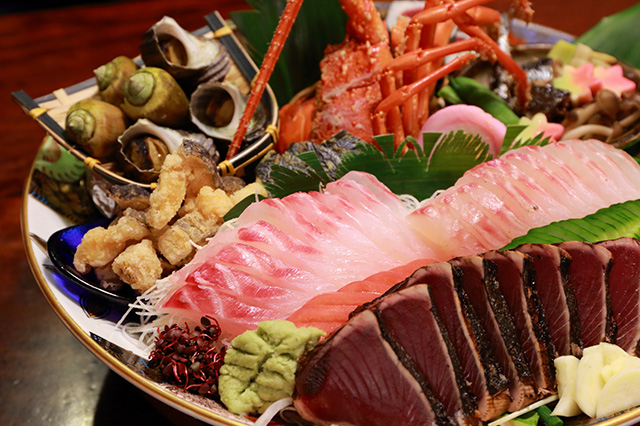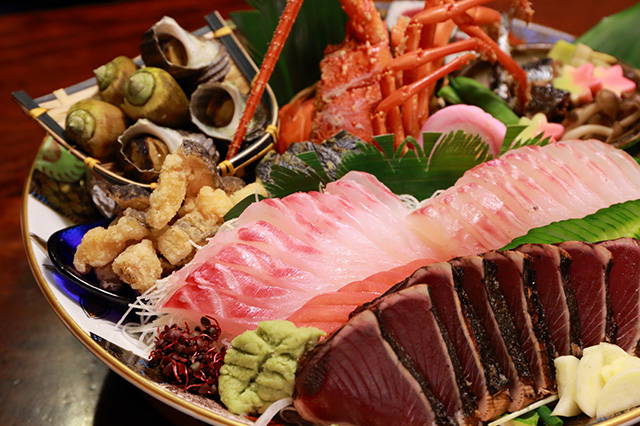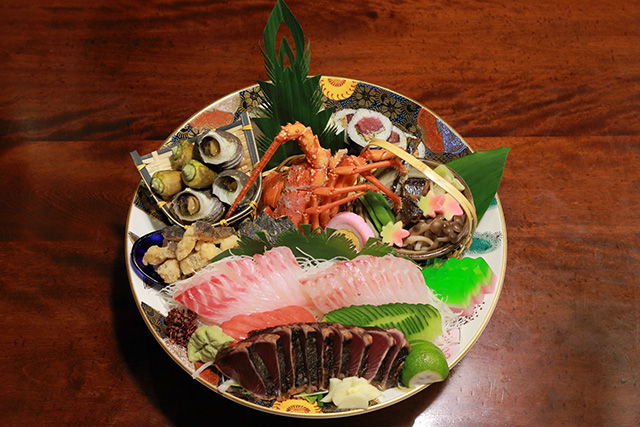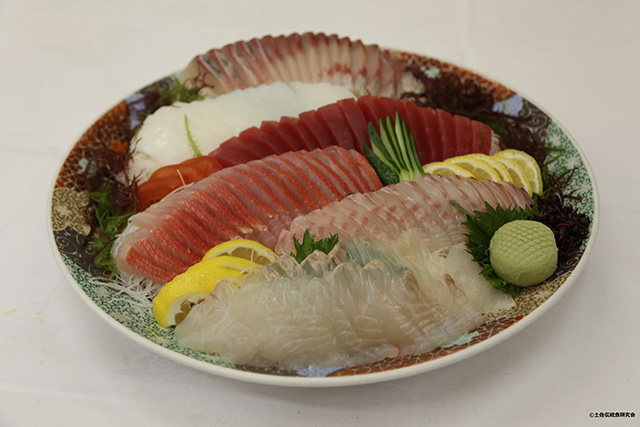Sawachi ryori | Our Regional Cuisines
-
Kochi Prefecture
Sawachi ryori
Image Source : Tosa Traditional Food Research Society
-
Main lore areas
Throughout Kochi prefecture
-
Main ingredients used
Sushi, skipjack tuna tataki, sashimi, stewed and fried foods etc
-
History/origin/related events
The representative cuisine of Kochi prefecture is sawachi ryori. This is not the name of a specific dish, but rather a style of cuisine where food from the mountains and sea, that Kochi abounds in, are lavishly dished up on a large platter (36-39cm). Various kinds of food are served up: seasonal raw fish dishes such as sashimi or skipjack tuna tataki; varieties of sushi including sugata zushi and inaka zushi (vegetable sushi); platters known as kumimono where sushi is served alongside stewed items, foods dressed with various sauces, deep-fried food, or sweets and fruits. There are also platters serving items such as steamed bream, somen noodles, and zenzai (a soup made from azuki beans).
In Kochi, inviting guests over for a feast is known as "okyaku"; even today, okyaku culture is deeply rooted. Sawachi ryori arose as a way of serving food during these okyaku. It was created as a way to serve about three servings of food on one dish. The food is replenished as it is eaten. You can recognise the scale of an okyaku party by the number of platters served.
The origins of sawachi ryori date back to the Edo period, when food would be served on great platters at the end of samurai banquets. Eventually, it spread further after the Meiji period, as okyaku cuisine. It was also a symbol of one's social status: wealthy families would gather expensive Imari, Kutani and Arita ware dishes, and store accessories in their storehouses such as sake cup stands and lacquerware stands to place their platters on. -
Opportunities and times of eating habits
This is not food for everyday occasions: it is served at important ceremonial events, celebrations of a new birth, a 60th birthday, seasonal festivals, housewarmings, and various other occasions where one has guests. The men generally prepare the fish while the women handle the rest of the cooking. The pre-cooking preparations take time, sometimes as much as two days.
Historically, agricultural communities that shared farm work together would be organised into groups known as yui, These would be further divided into subgroups known as shiru yui, who would help to cook, set the table and clean up when an okyaku was held. These groups would contain some amateurs, but also people known for their culinary skills. It is said that locals would assess each other on their respective skills: "that house does the best sushi", "when it comes to tataki, the old man at that house is the best", and so on. -
How to eat
The food served on the larger platter is surrounded by a crowd of people, who each have a smaller plate they use to divide the food amongst themselves. They can take whichever items they like, making it a handy way of serving food at okyaku.
-
Efforts for Preservation and Succession
(Outline of the traditions, the preservation society, social media use, modern approaches at commercialization)
Over time, the shiru yui groups disappeared from village life. On the other hand, ever since the rapid economic growth of the late 1950s, caterers offering sawachi ryori in all areas of Japan have proliferated. Because of this, the scale of the cuisine has increased, and arrangements have grown ever more extravagant. Platters of fresh foods and kumimono are still the main focus, but in recent years quite a few Western dishes, such as roast beef and fried prawns, have also been introduced.
Restaurants in Kochi also offer sawachi ryori dishes for small groups.
source : Kochi Prefecture Agricultural Produce Marketing Strategy Division, Tosa Traditional Food Research Society
Contact
Food Cultures Office, Overseas Market Development and Food Cultures Division, Food Industry Affairs Bureau, Ministry of Agriculture, Forestry and Fisheries
Tel:+81-3-3502-5516










